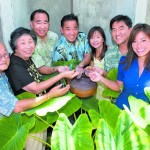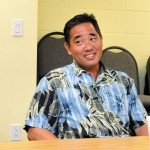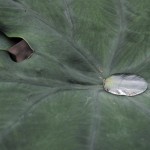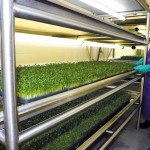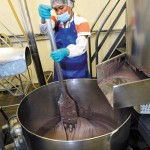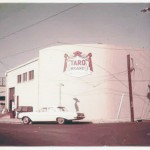O, Opi!
Four generations of Tottoris have made Taro Brand synonymous with that most Hawaiian of foods, poi. The tradition continues with sprouts and cut vegetables produced in the cleanest plant you’ve ever seen
This is a poilific poitrayal of an industrious and innovative family that poiduced and poifected an industry synonymous with Hawaii.
You’d be poifectly right to poisume that their story has something to do with poi. (Or that our spellcheck is lolo.)
This is the enchanting story of the Honolulu Poi Company, Hawaii’s foremost taro processor and creator of Taro Brand products. You’ve seen its familiar label in your grocery store. But do you know the players behind the poi and products?
- The Tottori ohana (from left): Ernest, Miriam, Brian, Paul, Ann, Craig and Michelle. Photo by Nathalie Walker
- The Tottori ohana (from left): Craig, Michelle, Miriam, Ernest, Ann, Paul and Brian. Photo by Nathalie Walker
- Workers wash taro corms before cooking. Photo by Nathalie Walker
- Ernest Tottori (right) with an old-school taro boiler | Tottori family photo
- Mark Koga grows Taro Brand’s taro near Hanalei, Kauai. He’s pictured here with his children (from left) Miya, Mya, Ali and Kai | Daniel Lane photo
- At age 79, Ernest Tottori has been involved with the company since he was 18. Photo by Nathalie Walker
- A dop of rain in the center of a taro leaf in former times was a gift to ali‘i. Photo by Nathalie Walker
- Workers prepare a tray of fresh Taro Brand sprouts for market. Photo by Nathalie Walker
- That’s a lot of poi to stir. Photo by Nathalie Walker
- The iconic Taro Brand logo on an old tank. Tottori family photo
Like taro, HPC Foods Ltd., as the company is known today, has deep roots in the Islands.
It was founded in 1946 by Japanese immigrant-farmer Kakuichi Tottori, who started a poi milling operation with three employees in Waipahu. Today, it is a food service titan with 180 employees and diversified product line.
What made this company take root and thrive while others sunk in the mud?
How did the Tottori family emerge a pioneer and standard-bearer of taro cultivation and poi production?
What is being done to spur growth and profitability for this niche product so it does not fade into obscurity?
We will explore these poivocative questions and poivide answers.
The Roots
Before venturing into poi production, first-generation farmer Kakuichi Tottori had a dairy in Kipapa and was one of the first to ship fresh pineapple to California.
Grandson Ernest Tottori, 79, chairman of HPC Foods, recalls, “My grandfather was a very adventurous man. He had a very good business sense. Right after the war, I don’t know what made that old man with the crazy idea to go into poi, but he started Honolulu Poi in summer 1946.
“When the war ended, my grandfather asked my father, James Ichiro Tottori, to run Honolulu Poi. Then, I took over in 1952 (at age 18),” Ernest Tottori recounts in an oral history.
At the time, there were 10 or 12 poi factories on Oahu. The two largest operations were Waiahole and Waimea Poi.
Ernest grimaces as he recalls the long hours and hard work demanded of him by his grandfather.
“Hard work? Ha!” he exclaims. “One New Year’s Day, I tell him it’s holiday. He tells me, ‘Oh, today half a day.’
“After my grandfather died, I paid off his debts, sold his farm and went into vegetable and taro farming at Waimanalo until 1954. I lost all my savings and turned to my father. At the same time, he wasn’t having a good time too,” Ernest relays. “So we teamed up and concentrated on Honolulu Poi Company. I took over general management in 1962.”
The family-run business continues today with a fourth-generation team. Youngest son Craig Tottori, 48, is president, supported by eldest brother Brian, 54, who supervises information technology, sister Ann Kinoshita, community relations, and brother Paul, 50, who oversees equipment and maintenance.
Ernest’s wife, Miriam, serves as executive vice president/corporate secretary. Craig’s wife, Michelle Tang, a 30-something dynamo in food service distribution and marketing, serves as general manager. She has previous experience at ‘Nalo Farms, Armstrong Produce and Coca Cola Bottling Co. of Hawaii.
The corporate ohana runs a dynamic yet, in many ways, unassuming enterprise based on Libby Street in Kalihi, where the Tottori kids grew up. What was once “home” is now a 9,000-square-foot central distribution building where poi and sprouts are produced and packaged. A short drive away, near Waiakamilo Road, is a 15,000-square-foot facility where fresh-cut fruit and vegetables are processed and packaged.
A fleet of 25 refrigerated trucks rolls out several times a week to deliver poi and other fresh food items to grocery stores, retail outlets, restaurants and institutions.
HPC is Hawaii’s largest poi manufacturer, producing more than 30,000 pounds a week, or more than 1 million pounds annually. Eighty percent of poi is sold through retail outlets, and 20 percent is sold for private luaus.
HPC uses the lehua variety of taro, richly cultivated in Hanalei, Kauai. Being farmers themselves at one time, the Tottoris for many years had a taro experimental growing farm in Haleiwa where they nurtured knowledge to help farmers. That exchange has resulted in higher crop yields to blunt taro shortages.
A key component of poi production is a Tottori-designed pressure cooker that can cook more than 6 tons of taro an hour. No more boiling taro in small batches for four to five hours.
Ernest was a welder by trade and did most of the equipment fabrication.
“He always pushes the philosophy of doing things yourself,” son Paul says. “Businesses in Hawaii are isolated, so when problems arise, you have to be self-reliant. Even today, the company has a maintenance department that is fully equipped with backup equipment and parts, and most of the renovations and expansions are done or overseen in-house.”
Crowning Kalo
Self-reliance and sustainability are familiar Tottori themes.
“If you’re going to perpetuate poi, supply is always going to be a concern,” admits Craig. “That’s why we partner with local farmers to cultivate taro for the best yield and quality. Supply of poi had been declining. First, we had to shore up the supply. Now, we can turn our sights to sales and marketing.”
Ernest observes, “In any business, it’s about supply and demand. Poi is a luxury item, in a sense, subject to fluctuating supply.”
Craig adds, “But now that we are able to buy whatever farmers produce and share knowledge with them about higher yields, we are more confident of meeting demand.”
An HPC marketing plan calls for increased brand visibility in print media and e-commerce. Ads herald the nutritional benefits of poi with its fat-free, hypoallergenic, vitamin-rich qualities.
New product development will roll out premium frozen poi for the Mainland market and convenient 16-ounce combo packs of poi and lomi lomi salmon. The frozen poi in 16-ounce bags easily can be reconstituted by thawing and microwaving to bring back the fresh, sweet taste of poi. Ex-pats with the onos for island poi will love it.
Sprouting Growth
In addition to poi, HPC produces the state’s largest supply of freshly grown sprouts and cut fruits and vegetables under the Taro Brand label. Some 60,000 pounds of sprouts are cultivated in-house every week. Varieties include soy, mung bean, clover, broccoli and radish sprouts. A current ad campaign reminds consumers of the health benefits of sprouts, a rich source of vitamins, nutrients and antioxidants. Fresh-cut produce sold statewide also includes Taro Brand chop suey mix, salad mix, and celery and carrot sticks.
The transition to vegetable and food distribution spurred a corporate identity change in 1990 from Honolulu Poi Company to HPC Food Ltd., according to Craig, a finance major who was educated at Iolani, Moanalua High and University of Hawaii.
“This change symbolizes a commitment to continued growth and diversification in the food industry,” he says.
Asked the biggest operational opportunity for the company, Craig and Michelle touted the major investment and commitment to food safety.
Driven by consumer and supplier concerns, industry disciplines must carefully address handling, preparation and storage of food to prevent food-borne illnesses. HPC Foods has responded by establishing an in-house quality assurance department and laboratory to do product testing so that all procedures are traceable. It proudly points to its Global Food Safety Initiative (GFSI) Certification as proof of meeting and exceeding industry standards.
Poi Posterity
Finally, we ask HPC leaders to wax philosophical about poi, Hawaii’s soul food. It is cultural cuisine for islanders, yet a mysterious pale-gray paste for visitors. Like Rodney Danger-field, it still gets no respect. Even the GEICO gecko refers to poi in a current commercial: “Poi … whatever that is.”
Patriarch Ernest observes, “Commercial luaus need to teach visitors how to eat poi. As a stand-alone staple, it might not appeal to people’s taste. It’s like eating raw fish for the first time.”
“Even the young generation needs to be educated about poi,” adds daughter-in-law Michelle. “Our grab-and-go combo pack of poi and lomi salmon – at 190 calories – could be the crossover product.”
She adds: “It is Hawaiian cuisine, but it is a health food, too. With consumers becoming more health-conscious and looking for foods made with fresh, natural ingredients, poi has a huge potential.”
Well, there you have it. The kamaaina family that has sustained poi production – never veering off course even when foreign taro invaded the market – says the future of poi is to stick with it.
Like its consistency, once you put your fingers into poi, don’t lose a drop of it, savor it and taste the goodness it brings. Remember the good times at luaus and family gatherings when Hawaiian food brings people together in a spirit of aloha.
Then and only then will you have a proper poispective.

